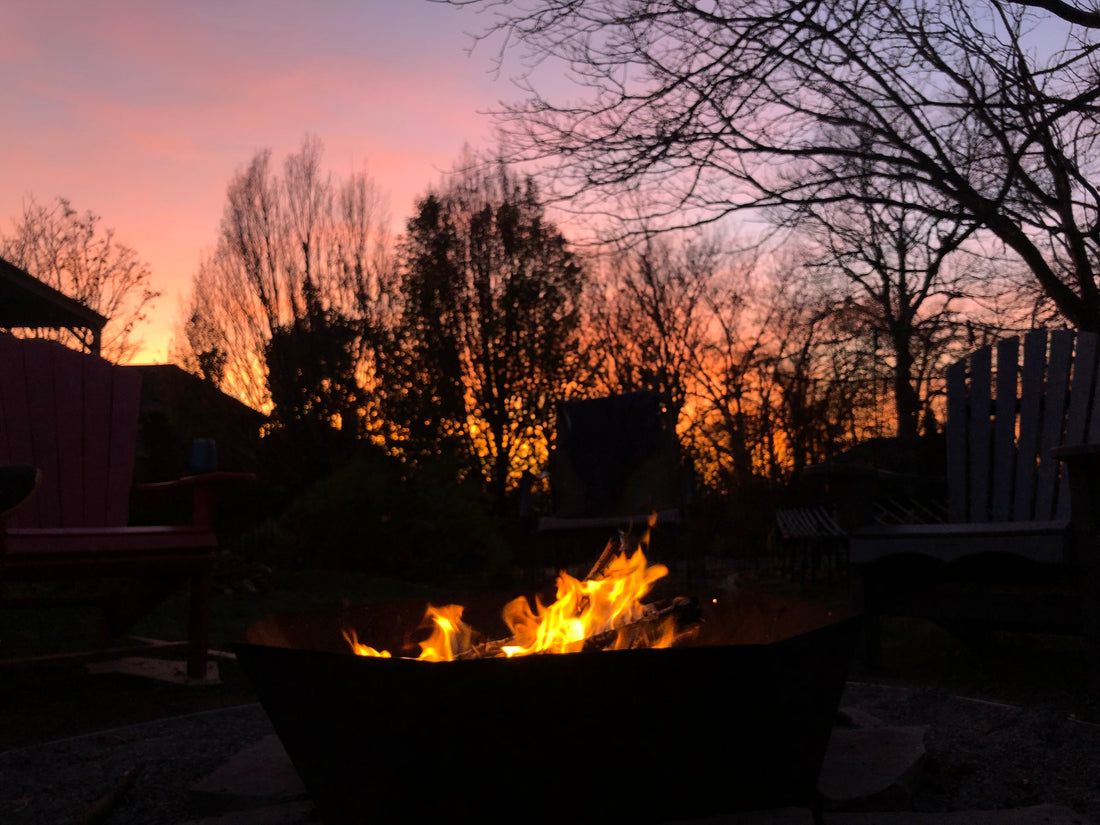
Backyard Fire Pit
By Dean Sprung
During this time of COVID, sitting around an open fire provides a safe and fun ‘social distance gathering’. It offers fresh air, conversation and time to try more Ontario craft beer.

We’ve gone through a few big box backyard fire pits over the past 20 years but none of these compare to our made in Ontario Iron Embers Cupola Fire Ring. The safety, heat and display of flames dancing in the breeze is remarkable. This model is an open ring on the bottom and rests directly on the ground. I ended up making this a permanent feature in our backyard by constructing a proper base.
Shop for popular Iron Embers models in our Reno FX online store.
Build your own backyard fire pit

A 7’ diameter is ideal for pits up to 36” wide. This provides a good buffer between sparks and the grass and people sitting around the fire. Put a wooden or metal stake in the ground right in the centre of where the fire pit will be going. Tie or loop string around the stake and with a tape measure, mark 42” on the string from the stake. With a can of marking paint at the mark, pull the string taught as you spray and walk around the stake to create a 7’ diameter painted circle.
If this area is graded or sloped, you may need to build up the low side with topsoil. Align two long wooden stakes opposite of each other from the centre of the pit. Do this so that one stake is in the high ground and the other is in the low ground approximately 10’ to 12’ apart. Tie a string to each stake about 2’ from the ground. Use a level to make sure the string is level between the two stakes. Measure the distance between the high ground and the string and then between the low ground and the string. The difference between the two measurements is how much you need to build up the low end of the fire pit area to be level.
This next step is to prevent pooling of water from rain or when dousing the fire with a hose or bucket. This also removes roots in the ground which could catch fire and spread to trees. Dig inside the 7’ diameter about 6’ to 10’ deep. Add 3/4” clear limestone leaving about 2” - 3” from the surface. Add a layer of landscape fabric over the stone to keep the next layer separate from the stone. Add 1” of HPB (high performance bedding). If your fire will be directly on the ground, use fire bricks. Fire pits or bowls with legs can go directly on your finished surface. Build out enough fire bricks from the centre for the fire ring to sit on. Fire bricks have a high heat rating and cost less than $3 per brick. Avoid using manufactured stone as it will crack from the heat and pea gravel as this stone will explode from direct contact to the heat of the fire. As an option to contain the next layer of HPB, use two lengths of landscape aluminum edging and bend it to create a ring around edge of the hole. Lock it down with metal ground stakes. Add more HPB so that it is level to the fire bricks, aluminum ring or ground.

Place the fire ring right on the fire bricks and lay your choice of natural or manufactured stone around the fire ring. If you have your pit on legs, finish the top layer before setting the fire pit.
Wood
A face cord of hardwood will be $150 to $200. I love maple. It burns efficiently, provides good heat and smells like Canada. Oak, ash, birch, elm, beech and poplar are good alternatives. Walnut is good if you are not using it for live edge tables or charcuterie boards. Softwoods are good for kindling. Pine, cedar, spruce can be cut into thin pieces. Don’t use these for your main heat source as they do spread a lot of sparks.
Pairings

Enjoy with a Collective Arts, Stranger Than Fiction Porter.
Safety
Don’t leave the fire unattended. It could become a hazard for surrounding brush, trees and children nearby.
Have a water filled bucket or garden hose nearby for dousing.
Restrictions and Bylaws
Your municipal office or local fire station will have the policies and bylaws for backyard campfires.
- A permit maybe required
- Restrictions on the size of fire
- Proximity to property line
- Proximity to structures (house, shed, deck)
- Time of day use
- Fire bans during drought conditions
- Limits on the number of people outdoors for social gatherings due to COVID-19
Shop
Discover popular models for your home or cottage on the Reno FX store.
Social Connections
@RenoFX_Media, @ONforestfires, @collectivebrew
#campfire #outdoorliving #ironembers
Dean Sprung is a general contractor, author of House Effects, certified flood risk assessor and contributing writer for Reno FX.
Reno FX Media provides expertise and discoveries in renovating, organizing, outdoor living and entertaining at home. Shop・Learn・Plan・Share




